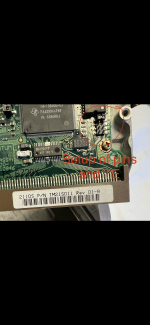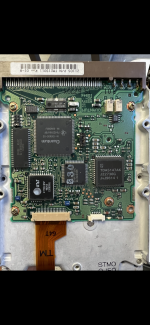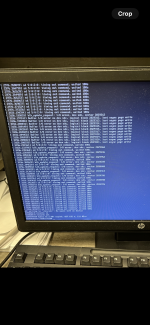Hello.
I’m now trying to clone a 50 pin SCSI drive on XW8000 machine. The cable is 68 pin SCSI and has a terminator at the end, my dd command is able to copy the drive to USB without errors, but whenever I try to restore the file into an identical HDD, it gives me these errors:
Are these bad sectors on the drive? Or do you think a cable problem? I’ve changed my set up twice and still same errors. However, I would think I could boot the drive at least partially, and nothing is coming up.
System is able to recognize drive and access it, as I can create an identical .img file on my USB drive (USB 3, formatted EXT4). I’m using:
dd if=/dev/sda of=/dev/sdb bs=512 conv=sync,noerror
I’m using a simple 50 pin 68 pin adapter to connect drive from cable harness. My master drive is connected to harness and running Ubuntu.
I’ve tried doing this on other 50 pin. SCSI drives, and it worked without problems.
I’m thinking the issue is the drive termination or setup.
The p/n drive I’m trying to clone is TM21S001, and I’ve connected the 50 SCSI drive with the 68 pin SCSI cable using a male 68 pin to make 50 pin SCSI adapter. I’ve cloned other 50 pin SCSIs with it with no issues. I am thinking that my problem is something with termination of LVD v SE. I’ve set the drive to SCSI ID 2. And last thing. I’ve tried this with 3 different quantum drives and they all give me the similar issues
Any ideas on what I could try?
I’m now trying to clone a 50 pin SCSI drive on XW8000 machine. The cable is 68 pin SCSI and has a terminator at the end, my dd command is able to copy the drive to USB without errors, but whenever I try to restore the file into an identical HDD, it gives me these errors:
Buffer I/O error on dev sdc, logical block 1792, lost async page write.
Are these bad sectors on the drive? Or do you think a cable problem? I’ve changed my set up twice and still same errors. However, I would think I could boot the drive at least partially, and nothing is coming up.
System is able to recognize drive and access it, as I can create an identical .img file on my USB drive (USB 3, formatted EXT4). I’m using:
dd if=/dev/sda of=/dev/sdb bs=512 conv=sync,noerror
I’m using a simple 50 pin 68 pin adapter to connect drive from cable harness. My master drive is connected to harness and running Ubuntu.
I’ve tried doing this on other 50 pin. SCSI drives, and it worked without problems.
I’m thinking the issue is the drive termination or setup.
The p/n drive I’m trying to clone is TM21S001, and I’ve connected the 50 SCSI drive with the 68 pin SCSI cable using a male 68 pin to make 50 pin SCSI adapter. I’ve cloned other 50 pin SCSIs with it with no issues. I am thinking that my problem is something with termination of LVD v SE. I’ve set the drive to SCSI ID 2. And last thing. I’ve tried this with 3 different quantum drives and they all give me the similar issues
Any ideas on what I could try?




